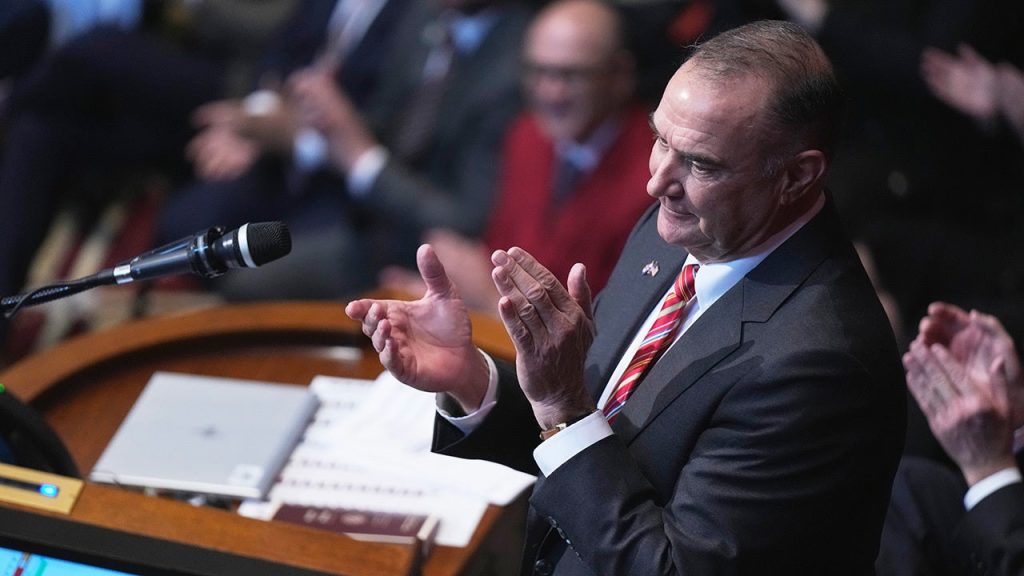Trump Scores Win as Missouri Governor Signs Redistricting Map
President Donald Trump has secured another victory in the ongoing redistricting battle between Republicans and Democrats as Missouri Governor Mike Kehoe signed the “Missouri First” congressional map into law. This new map is expected to flip a Democratic seat, giving Republicans an additional representative in the U.S. House ahead of the 2026 midterm elections. The development in Missouri represents the latest move in a nationwide chess match over district boundaries, with both parties seeking to maximize their electoral advantages in what has become an increasingly high-stakes political struggle that could determine control of Congress in the coming years.
Missouri, once considered a competitive swing state, has shifted dramatically rightward over the past 15 years, making it fertile ground for Republican redistricting efforts. Governor Kehoe proudly announced his signing of the map, stating it “best represents Missourians” while acknowledging the support of state legislators, the congressional delegation, and President Trump in bringing the legislation to fruition. Trump himself celebrated the new map on social media, calling it “FANTASTIC” and highlighting how it would help send an additional “MAGA Republican” to Congress. The redistricting primarily targets Democratic Representative Emanuel Cleaver’s Kansas City-area district by expanding it eastward to include more conservative rural voters, likely flipping this long-held Democratic seat and giving Republicans a commanding 7-1 advantage in Missouri’s House delegation.
Democrats have not accepted these changes quietly. Representative Cleaver has promised legal action against the new map, warning that fighting “fire with fire” would leave nothing but “ashes.” He cited polling data suggesting the redistricting plan is “immensely unpopular” among Missourians. Missouri House Minority Leader Ashley Aune went further, accusing Republicans of attempting to “rig our maps and eliminate our representation in Congress.” These objections highlight the bitter partisan divide over redistricting efforts, with each side accusing the other of unfair manipulation of electoral boundaries for political gain while defending their own similar actions as necessary corrections to perceived imbalances.
The Missouri redistricting follows closely on the heels of similar efforts in Texas, where Republican Governor Greg Abbott recently signed legislation aimed at creating up to five right-leaning congressional districts at the expense of Democrat-controlled seats. These coordinated Republican efforts represent a strategic attempt to solidify and expand their narrow House majority before the 2026 midterms, when the party in power traditionally faces electoral challenges. Trump and his political team appear determined to avoid repeating the outcome of the 2018 midterms, when Democrats reclaimed House control during his first term in office. This mid-decade redistricting is unusual but not unprecedented, reflecting the extraordinarily high stakes of contemporary American politics and the razor-thin margins separating the parties in Congress.
Democrats are mounting their own counteroffensive in the redistricting battle. In California, state lawmakers have approved a special ballot proposition for November that would temporarily bypass the state’s nonpartisan redistricting commission and return map-drawing power to the Democrat-controlled legislature. This effort, championed by Governor Gavin Newsom, aims to create five more Democratic-leaning districts to offset the Republican gains in Texas. With Democrats needing just three additional seats to reclaim the House majority in 2024, both parties are exploring every available redistricting opportunity. Republicans in Indiana, South Carolina, Florida, Kansas, and Nebraska are considering new maps, while Ohio faces a court order to redraw its districts before the midterms. Meanwhile, Democrats are looking to New York, Illinois, and Maryland as states where they might create more left-leaning seats.
The nationwide redistricting struggle has also encountered legal challenges that could reshape certain states’ political landscapes. In Utah, a judge recently ordered the Republican-dominated legislature to draw new maps after ruling lawmakers had improperly ignored an independent commission established by voters to prevent partisan gerrymandering. These judicial interventions underscore the complex interplay between partisan political maneuvering and legal principles governing fair representation. As both parties intensify their redistricting efforts ahead of critical election cycles, the outcomes will significantly influence the balance of power in Washington and the ability of either party to advance its legislative agenda. With control of the House potentially hanging in the balance, these seemingly technical boundary adjustments have become central to America’s political future.


